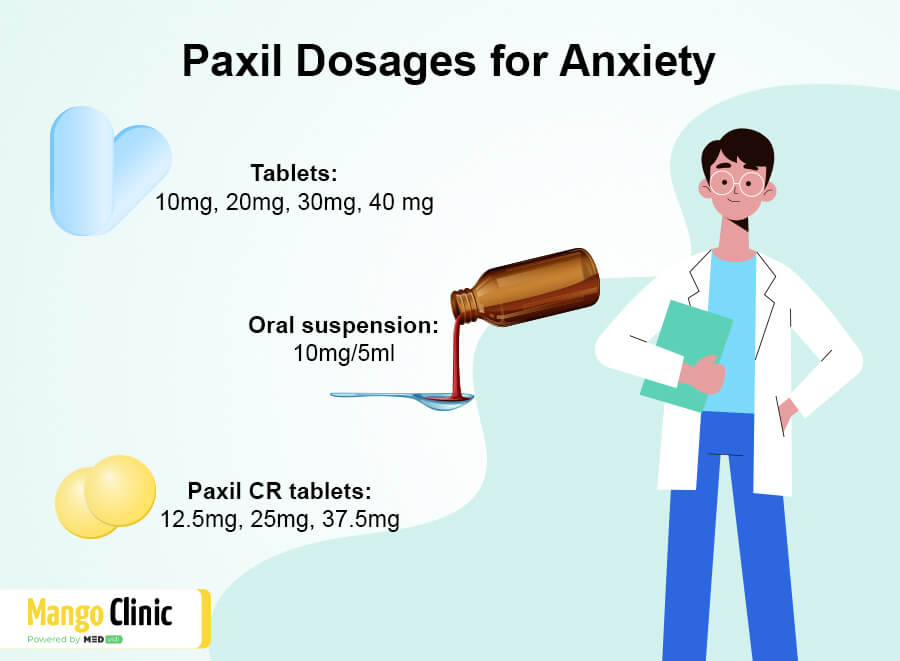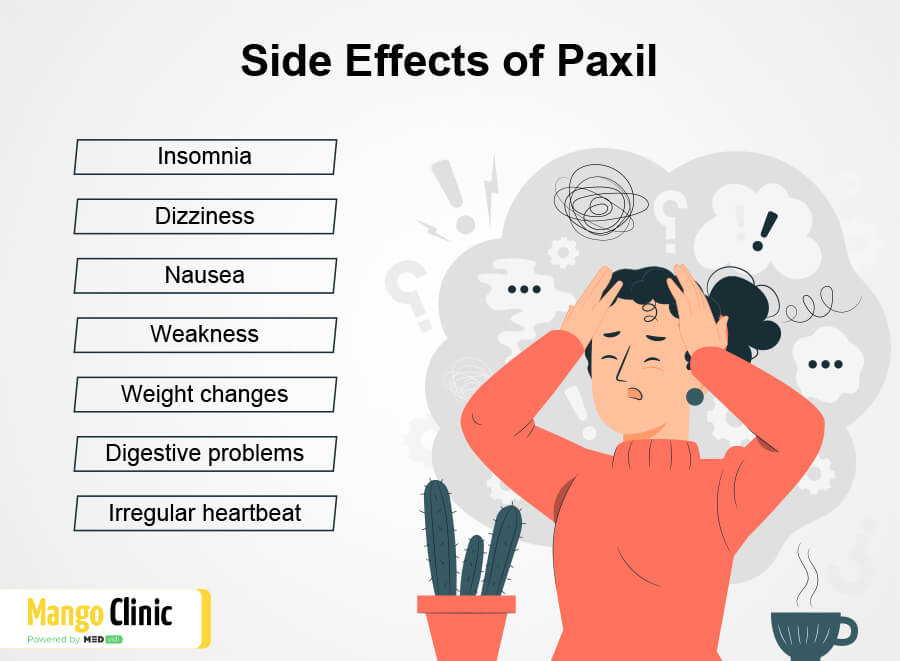How Does Paxil Work for Anxiety

Although doctors often use therapy to address mental conditions, some conditions require taking medication as part of the treatment plan. And when it comes to anxiety and panic disorders, Paxil is among the most commonly prescribed drugs. Read on to know more about this medicine, does Paxil help with anxiety, how does Paxil works, what are its withdrawal symptoms, and other important facts.
Contact a certified prescriber at Mango Clinic to get a prescription for a medication that will suit you best.
What Is Paxil
Paxil, also known as paroxetine, is a selective serotonin reuptake inhibitor (SSRI) drug. SSRI drugs increase the levels of serotonin—a natural chemical found in the neurotransmitters in the brain, which is responsible for one’s moods. The neurotransmitters work by transferring messages from the nervous system to the brain and the general body. Having enough serotonin means the body can generally function by maintaining one’s moods, sleep patterns, and how one perceives pain.
Due to such a mechanism of action, this drug improves the patient’s emotional state, reducing the main symptoms of anxiety and panic disorder. When patients have a mental condition such as anxiety or depression, their mood will be affected. Paxil will inhibit the neurons from reabsorbing the serotonin, supplying the brain with enough serotonin to improve one’s emotional state.
What Is Paxil Used for
Medics first used Paxil in the U.S. in the 1980s, and it has remained one of the most widely used drugs that treat anxiety. And although Paxil is commonly used to treat depression, social anxiety disorder, and panic attacks, doctors prescribe it for other mental conditions too, including:
- Bipolar Disorder
- Generalized anxiety disorder (GAD)
- Agoraphobia
- Obsessive-compulsive disorder (OCD)
- Premenstrual dysphoric disorder (PMDD)
- Post-traumatic stress disorder (PTSD)

How Long Does It Take for Paxil to Work
When patients take Paxil, the drug has a long process of fixing the serotonin imbalance in the neurotransmitters. The process of interrupting the reuptake process and inhibiting the reabsorption of serotonin to increase the serotonin levels in the brain can be slow. Therefore, Paxil takes about four to six weeks to make positive changes in the patient’s body.
How to Use Paxil for Anxiety
Paxil comes in liquid, 10mg, 20mg, 30mg, and 40 mg tablets, 10mg/5ml oral suspension, and Paxil CR tablet forms and is taken by mouth. Paxil CR is available in 12.5mg, 25mg, and 37.5mg tablets. The average dosage for Paxil is usually 10 to 20 mg once a day at the start of the treatment, either in the morning or evening. Although the patient can take Paxil without food, doctors recommend taking the drug with food to avoid stomach upsets or feeling dizzy. Whether the patient is taking the regular or extended-release tablets, the tablet should be taken whole and not chewed or crushed.
The liquid solution of Paxil often comes with a medicine dropper. It is necessary for patients to use the dropper instead of replacing it with a spoon because the spoon can often give wrong measurements leading to incorrect dosage. The patient should also shake the bottle before taking medicine to ensure it mixes well and does not settle at the bottom of the bottle.
In most cases, the doctor will prescribe a small dose of Paxil, and with time, the dosage may be increased depending on how the patient reacts to the medicine. Since Paxil takes about five weeks to show positive results, most patients are tempted to increase the dosage without instructions from the doctor. Doing so is dangerous and leads to a drug overdose.
If the patient forgets to take medicine, doctors advise them to take it as soon as they remember. If several hours have passed, the patient must skip that dose and take the next one. Taking two doses at once to make up for the missed dose can lead to overdose.
When the drug starts to take effect, it is wrong for the patient to stop taking the prescribed medication by themselves. The patient should instead consult the doctor, and he or she will assess the patient and reduce the dosage or stop the medication at an appropriate time.
Ask your doctor about the duration of treatment and when would you notice significant effect.
Withdrawal Symptoms
When the doctor sees it fit for the patient to stop the medication, the dosage will be reduced with time. This is a way to help the patient avoid withdrawal symptoms that may occur if the patient stops taking the medication at once. Sometimes, the withdrawal symptoms can be more severe than the patient initially experienced before treatment. The most common signs include:
- Anxiety
- Irritability
- Confusion
- Tiredness
- Nausea
- Headaches
- Insomnia
- Strange dreams
Side Effects of Paxil
Like every other drug, patients taking Paxil are likely to experience some side effects. However, patients react differently to medications, so the issues might vary from one patient to the other. The side effects are usually short-term and disappear as the patient’s body adapts to the medication. The most common side effects are:
- Insomnia
- Nausea
- Weight changes
- Constipation
- Sexual problems and low libido
- Dry mouth
- Dizziness
- Loss of appetite
- Feeling weak
- Irregular heartbeat
- Diarrhea
Paxil Interaction With Other Drugs
During the assessment period, the doctor requires the patient to fill out a form indicating any drugs they take. Whether it is vitamins, over-the-counter drugs, supplements, or herbal medication, the patient should list all of them to the doctor. Paxil can at times interact with some medications and cause an adverse reaction. Medications that increase serotonin levels in the brain, such as other antidepressants, can cause a fatal overdose if the patient takes them combined.
For example, combining Paxil with monoamine oxidase inhibitors (MAOIs) can easily lead to serotonin syndrome. A patient should wait more than two weeks before taking Paxil if they have been using MAOIs. Serotonin syndrome is characterized by the following symptoms:

- High fever
- Confusion
- Muscle spasms
- Stiff muscles
- Loss of consciousness
- Irregular heartbeat
Paxil also interacts with other drugs such as:
- Cimetidine
- Pimozide
- Linezolid
- Thioridazine
- Tramadol
- NSAIDs
- Antiarrhythmics
- Risperidone
- Intravenous methylene blue
Summing Up
Depending on the Paxil dosage for anxiety you are prescribed and what is your health history, you can experience the effects of this medication differently. Therefore, work closely with your doctor to get the treatment plan adjusted accordingly when needed and receive help if you experience any side effects. Any mental health condition should be handled promptly as soon as the patient recognizes the symptoms, so contact Mango Clinic and start treatment today!









